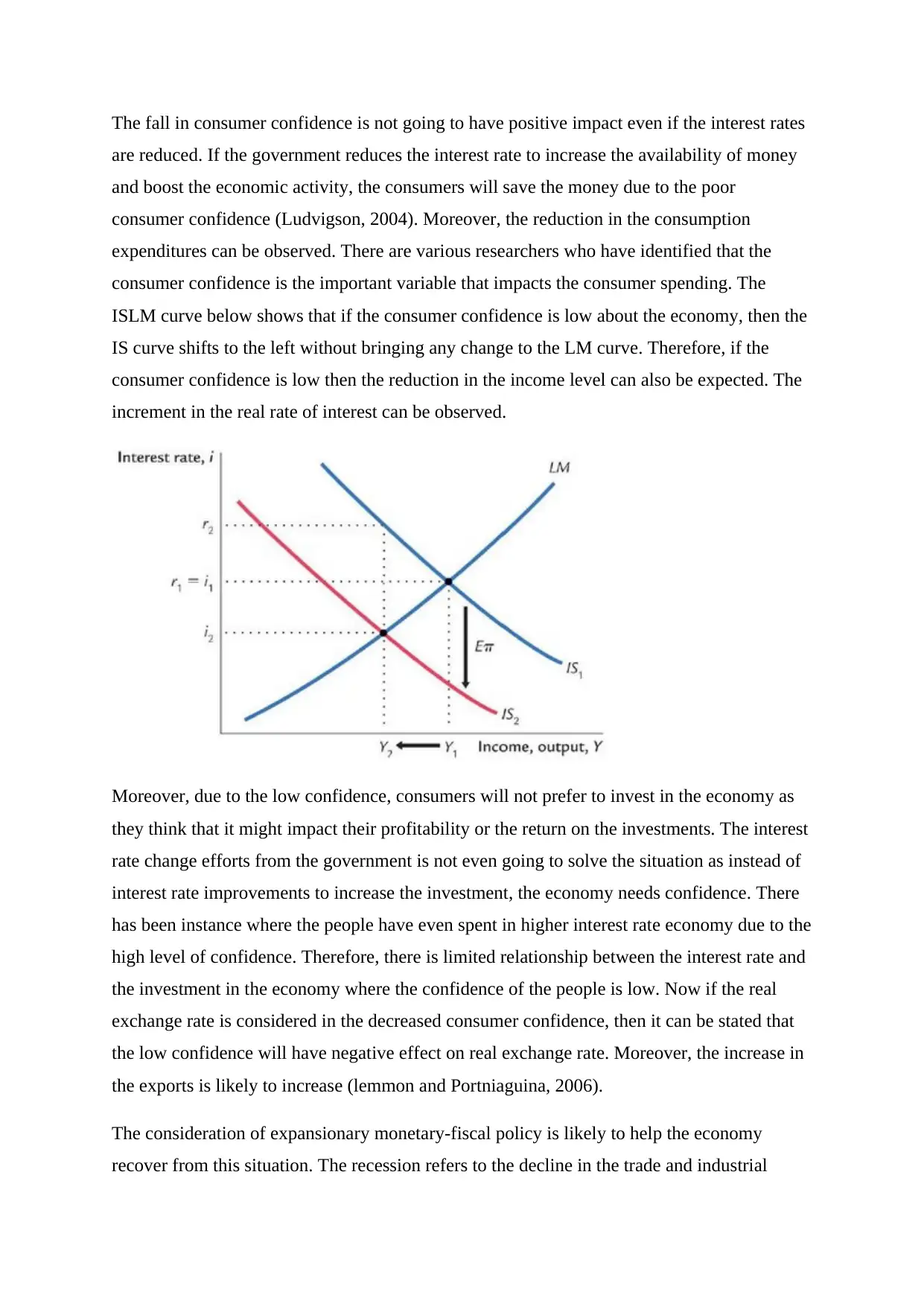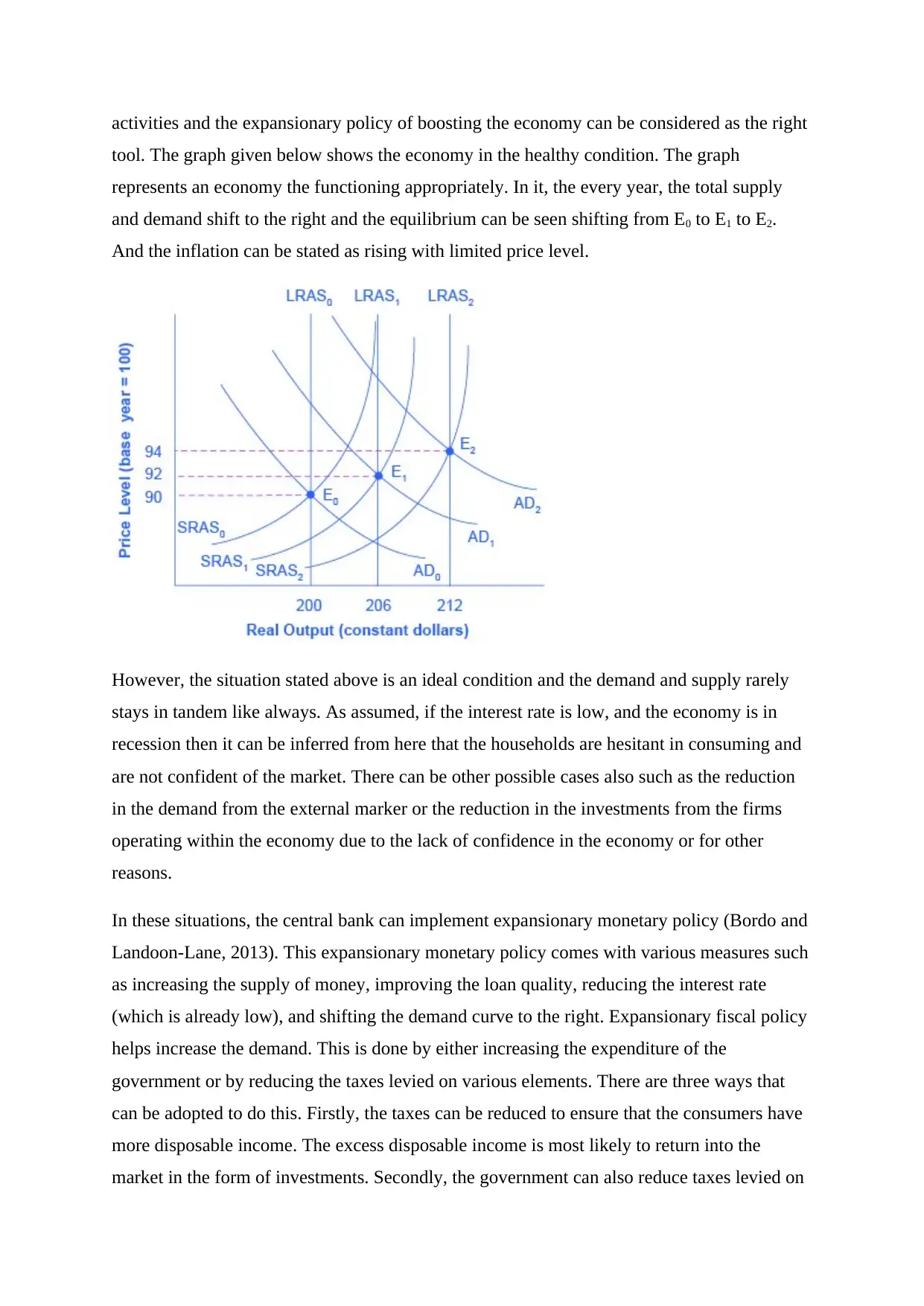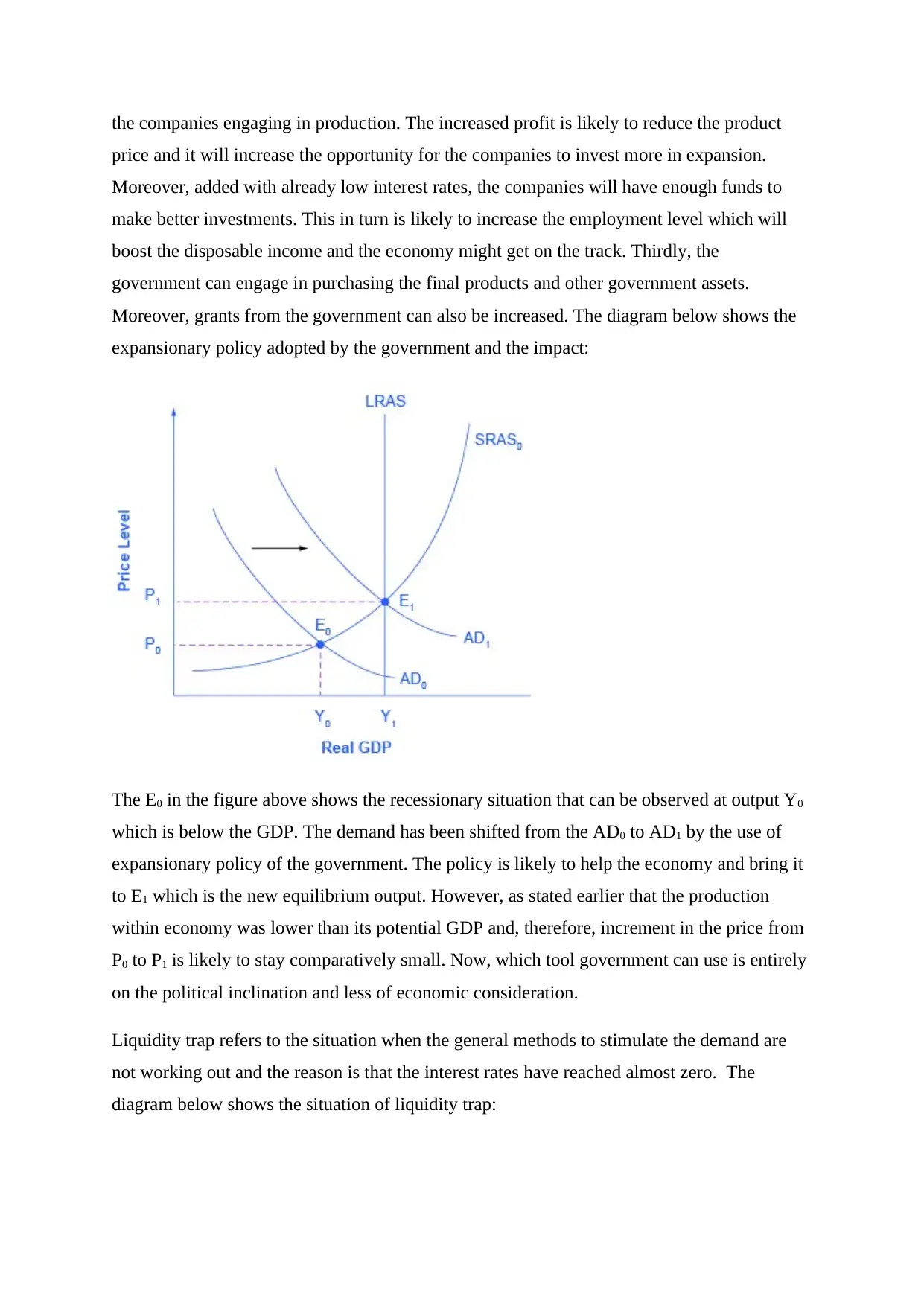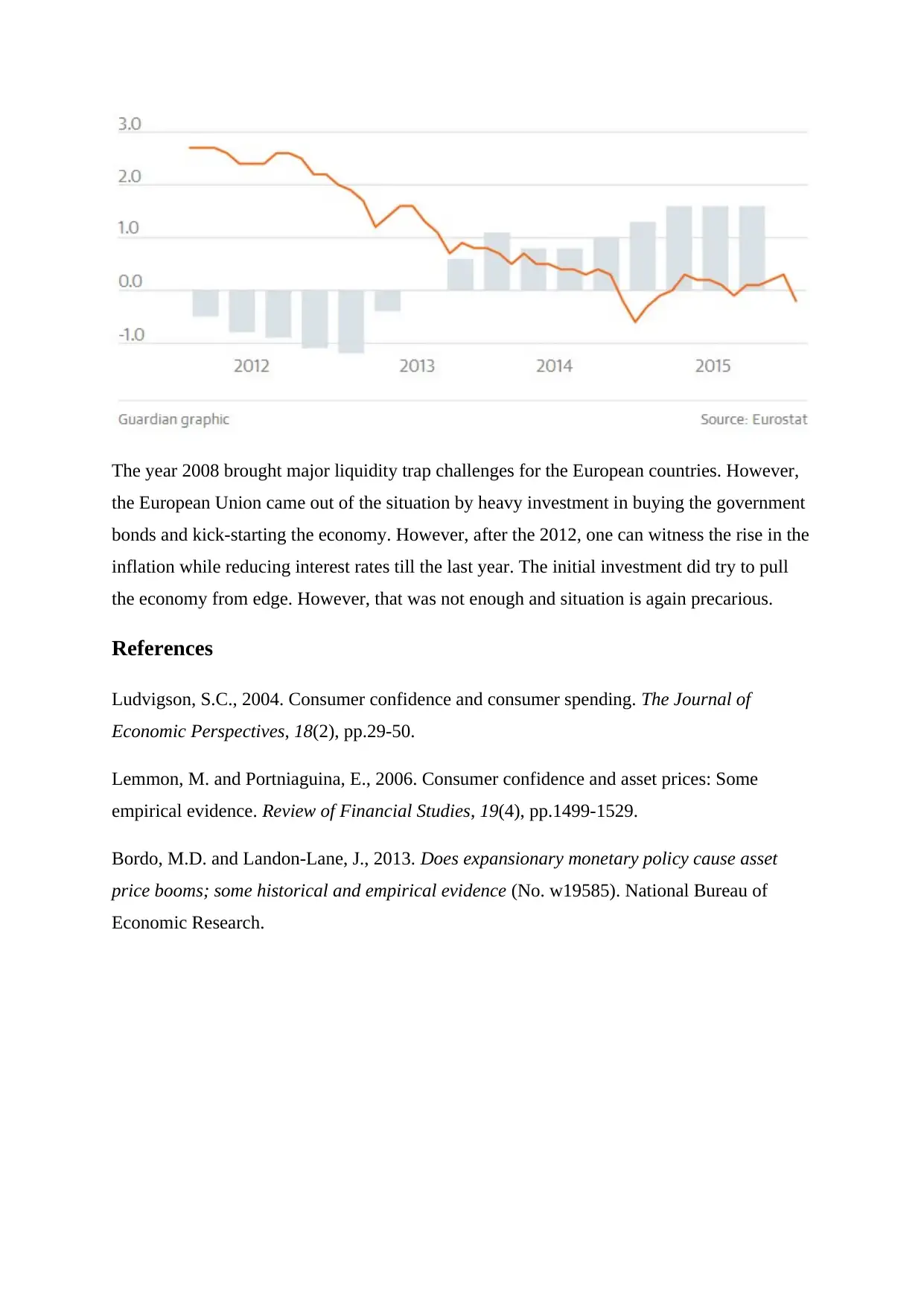Consumer Confidence and Economic Policy
VerifiedAdded on 2019/09/20
|4
|1134
|395
Case Study
AI Summary
This case study examines the impact of low consumer confidence on economic activity and the effectiveness of monetary and fiscal policies in addressing recessionary conditions. It discusses how reduced consumer confidence can negate the effects of interest rate reductions, leading to decreased spending and investment. The study also explores the use of expansionary monetary and fiscal policies, such as increasing the money supply, reducing taxes, and increasing government spending, to stimulate demand and shift the economy towards equilibrium. Additionally, it addresses the concept of a liquidity trap, where traditional methods of stimulating demand become ineffective due to near-zero interest rates, and provides examples of how governments have attempted to overcome such situations. The case study references academic research to support its analysis and provides a comprehensive overview of the challenges and potential solutions for managing economic downturns caused by low consumer confidence.

The fall in consumer confidence is not going to have positive impact even if the interest rates
are reduced. If the government reduces the interest rate to increase the availability of money
and boost the economic activity, the consumers will save the money due to the poor
consumer confidence (Ludvigson, 2004). Moreover, the reduction in the consumption
expenditures can be observed. There are various researchers who have identified that the
consumer confidence is the important variable that impacts the consumer spending. The
ISLM curve below shows that if the consumer confidence is low about the economy, then the
IS curve shifts to the left without bringing any change to the LM curve. Therefore, if the
consumer confidence is low then the reduction in the income level can also be expected. The
increment in the real rate of interest can be observed.
Moreover, due to the low confidence, consumers will not prefer to invest in the economy as
they think that it might impact their profitability or the return on the investments. The interest
rate change efforts from the government is not even going to solve the situation as instead of
interest rate improvements to increase the investment, the economy needs confidence. There
has been instance where the people have even spent in higher interest rate economy due to the
high level of confidence. Therefore, there is limited relationship between the interest rate and
the investment in the economy where the confidence of the people is low. Now if the real
exchange rate is considered in the decreased consumer confidence, then it can be stated that
the low confidence will have negative effect on real exchange rate. Moreover, the increase in
the exports is likely to increase (lemmon and Portniaguina, 2006).
The consideration of expansionary monetary-fiscal policy is likely to help the economy
recover from this situation. The recession refers to the decline in the trade and industrial
are reduced. If the government reduces the interest rate to increase the availability of money
and boost the economic activity, the consumers will save the money due to the poor
consumer confidence (Ludvigson, 2004). Moreover, the reduction in the consumption
expenditures can be observed. There are various researchers who have identified that the
consumer confidence is the important variable that impacts the consumer spending. The
ISLM curve below shows that if the consumer confidence is low about the economy, then the
IS curve shifts to the left without bringing any change to the LM curve. Therefore, if the
consumer confidence is low then the reduction in the income level can also be expected. The
increment in the real rate of interest can be observed.
Moreover, due to the low confidence, consumers will not prefer to invest in the economy as
they think that it might impact their profitability or the return on the investments. The interest
rate change efforts from the government is not even going to solve the situation as instead of
interest rate improvements to increase the investment, the economy needs confidence. There
has been instance where the people have even spent in higher interest rate economy due to the
high level of confidence. Therefore, there is limited relationship between the interest rate and
the investment in the economy where the confidence of the people is low. Now if the real
exchange rate is considered in the decreased consumer confidence, then it can be stated that
the low confidence will have negative effect on real exchange rate. Moreover, the increase in
the exports is likely to increase (lemmon and Portniaguina, 2006).
The consideration of expansionary monetary-fiscal policy is likely to help the economy
recover from this situation. The recession refers to the decline in the trade and industrial
Paraphrase This Document
Need a fresh take? Get an instant paraphrase of this document with our AI Paraphraser

activities and the expansionary policy of boosting the economy can be considered as the right
tool. The graph given below shows the economy in the healthy condition. The graph
represents an economy the functioning appropriately. In it, the every year, the total supply
and demand shift to the right and the equilibrium can be seen shifting from E0 to E1 to E2.
And the inflation can be stated as rising with limited price level.
However, the situation stated above is an ideal condition and the demand and supply rarely
stays in tandem like always. As assumed, if the interest rate is low, and the economy is in
recession then it can be inferred from here that the households are hesitant in consuming and
are not confident of the market. There can be other possible cases also such as the reduction
in the demand from the external marker or the reduction in the investments from the firms
operating within the economy due to the lack of confidence in the economy or for other
reasons.
In these situations, the central bank can implement expansionary monetary policy (Bordo and
Landoon-Lane, 2013). This expansionary monetary policy comes with various measures such
as increasing the supply of money, improving the loan quality, reducing the interest rate
(which is already low), and shifting the demand curve to the right. Expansionary fiscal policy
helps increase the demand. This is done by either increasing the expenditure of the
government or by reducing the taxes levied on various elements. There are three ways that
can be adopted to do this. Firstly, the taxes can be reduced to ensure that the consumers have
more disposable income. The excess disposable income is most likely to return into the
market in the form of investments. Secondly, the government can also reduce taxes levied on
tool. The graph given below shows the economy in the healthy condition. The graph
represents an economy the functioning appropriately. In it, the every year, the total supply
and demand shift to the right and the equilibrium can be seen shifting from E0 to E1 to E2.
And the inflation can be stated as rising with limited price level.
However, the situation stated above is an ideal condition and the demand and supply rarely
stays in tandem like always. As assumed, if the interest rate is low, and the economy is in
recession then it can be inferred from here that the households are hesitant in consuming and
are not confident of the market. There can be other possible cases also such as the reduction
in the demand from the external marker or the reduction in the investments from the firms
operating within the economy due to the lack of confidence in the economy or for other
reasons.
In these situations, the central bank can implement expansionary monetary policy (Bordo and
Landoon-Lane, 2013). This expansionary monetary policy comes with various measures such
as increasing the supply of money, improving the loan quality, reducing the interest rate
(which is already low), and shifting the demand curve to the right. Expansionary fiscal policy
helps increase the demand. This is done by either increasing the expenditure of the
government or by reducing the taxes levied on various elements. There are three ways that
can be adopted to do this. Firstly, the taxes can be reduced to ensure that the consumers have
more disposable income. The excess disposable income is most likely to return into the
market in the form of investments. Secondly, the government can also reduce taxes levied on

the companies engaging in production. The increased profit is likely to reduce the product
price and it will increase the opportunity for the companies to invest more in expansion.
Moreover, added with already low interest rates, the companies will have enough funds to
make better investments. This in turn is likely to increase the employment level which will
boost the disposable income and the economy might get on the track. Thirdly, the
government can engage in purchasing the final products and other government assets.
Moreover, grants from the government can also be increased. The diagram below shows the
expansionary policy adopted by the government and the impact:
The E0 in the figure above shows the recessionary situation that can be observed at output Y0
which is below the GDP. The demand has been shifted from the AD0 to AD1 by the use of
expansionary policy of the government. The policy is likely to help the economy and bring it
to E1 which is the new equilibrium output. However, as stated earlier that the production
within economy was lower than its potential GDP and, therefore, increment in the price from
P0 to P1 is likely to stay comparatively small. Now, which tool government can use is entirely
on the political inclination and less of economic consideration.
Liquidity trap refers to the situation when the general methods to stimulate the demand are
not working out and the reason is that the interest rates have reached almost zero. The
diagram below shows the situation of liquidity trap:
price and it will increase the opportunity for the companies to invest more in expansion.
Moreover, added with already low interest rates, the companies will have enough funds to
make better investments. This in turn is likely to increase the employment level which will
boost the disposable income and the economy might get on the track. Thirdly, the
government can engage in purchasing the final products and other government assets.
Moreover, grants from the government can also be increased. The diagram below shows the
expansionary policy adopted by the government and the impact:
The E0 in the figure above shows the recessionary situation that can be observed at output Y0
which is below the GDP. The demand has been shifted from the AD0 to AD1 by the use of
expansionary policy of the government. The policy is likely to help the economy and bring it
to E1 which is the new equilibrium output. However, as stated earlier that the production
within economy was lower than its potential GDP and, therefore, increment in the price from
P0 to P1 is likely to stay comparatively small. Now, which tool government can use is entirely
on the political inclination and less of economic consideration.
Liquidity trap refers to the situation when the general methods to stimulate the demand are
not working out and the reason is that the interest rates have reached almost zero. The
diagram below shows the situation of liquidity trap:
⊘ This is a preview!⊘
Do you want full access?
Subscribe today to unlock all pages.

Trusted by 1+ million students worldwide

The year 2008 brought major liquidity trap challenges for the European countries. However,
the European Union came out of the situation by heavy investment in buying the government
bonds and kick-starting the economy. However, after the 2012, one can witness the rise in the
inflation while reducing interest rates till the last year. The initial investment did try to pull
the economy from edge. However, that was not enough and situation is again precarious.
References
Ludvigson, S.C., 2004. Consumer confidence and consumer spending. The Journal of
Economic Perspectives, 18(2), pp.29-50.
Lemmon, M. and Portniaguina, E., 2006. Consumer confidence and asset prices: Some
empirical evidence. Review of Financial Studies, 19(4), pp.1499-1529.
Bordo, M.D. and Landon-Lane, J., 2013. Does expansionary monetary policy cause asset
price booms; some historical and empirical evidence (No. w19585). National Bureau of
Economic Research.
the European Union came out of the situation by heavy investment in buying the government
bonds and kick-starting the economy. However, after the 2012, one can witness the rise in the
inflation while reducing interest rates till the last year. The initial investment did try to pull
the economy from edge. However, that was not enough and situation is again precarious.
References
Ludvigson, S.C., 2004. Consumer confidence and consumer spending. The Journal of
Economic Perspectives, 18(2), pp.29-50.
Lemmon, M. and Portniaguina, E., 2006. Consumer confidence and asset prices: Some
empirical evidence. Review of Financial Studies, 19(4), pp.1499-1529.
Bordo, M.D. and Landon-Lane, J., 2013. Does expansionary monetary policy cause asset
price booms; some historical and empirical evidence (No. w19585). National Bureau of
Economic Research.
1 out of 4
Related Documents
Your All-in-One AI-Powered Toolkit for Academic Success.
+13062052269
info@desklib.com
Available 24*7 on WhatsApp / Email
![[object Object]](/_next/static/media/star-bottom.7253800d.svg)
Unlock your academic potential
Copyright © 2020–2025 A2Z Services. All Rights Reserved. Developed and managed by ZUCOL.





